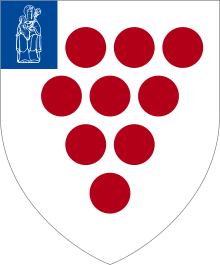
Back Katedrála ve Worcesteru Czech Eglwys Gadeiriol Caerwrangon Welsh Kathedrale von Worcester German Catedral de Worcester Spanish Worcesterko katedrala Basque کلیسای جامع ووستر Persian Worcesterin tuomiokirkko Finnish Cathédrale de Worcester French Ardeaglais Worcester Irish Katedral Worcester ID
| Worcester Cathedral | |
|---|---|
| Cathedral Church of Christ and Blessed Mary the Virgin | |
 Worcester Cathedral | |
| 52°11′20″N 2°13′15″W / 52.18889°N 2.22083°W | |
| Location | Worcester (Worcestershire) |
| Country | United Kingdom |
| Denomination | Church of England |
| Previous denomination | Catholic |
| Website | worcestercathedral.co.uk |
| History | |
| Former name(s) | Worcester Priory |
| Architecture | |
| Functional status | Active |
| Style | Norman, Gothic |
| Years built | 1084–1504 |
| Specifications | |
| Length | 130 m (426.51 ft) |
| Nave length | 53 m (173.88 ft) |
| Width | 44 m (144.36 ft) |
| Nave width | 9 m (29.53 ft) |
| Nave height | 20 m (65.62 ft) |
| Number of towers | 1 |
| Tower height | 62 m (203.41 ft) |
| Bells | 16 hung for change ringing |
| Tenor bell weight | 48cwt - 0qr - 2lb in B |
| Administration | |
| Province | Canterbury |
| Diocese | Worcester (since 670) |
| Clergy | |
| Bishop(s) | vacant |
| Dean | Stephen Edwards |
| Precentor | John Paul Hoskins |
| Canon(s) | Kimberly Bohan (Canon Librarian) |
| Honorary priest(s) | Minor Canons: Mark Dorsett & Robin Parry |
| Laity | |
| Organist(s) |
|


Worcester Cathedral, formally the Cathedral Church of Christ and Blessed Mary the Virgin, is a Church of England cathedral in Worcester, England. The cathedral is the seat of the bishop of Worcester and is the mother church of the diocese of Worcester; it is administered by its dean and chapter. The cathedral is a grade I listed building and part of a scheduled monument.[1][2]
The cathedral was founded in 680. The earliest surviving fabric dates from 1084, when the cathedral was rebuilt in the Romanesque style by Bishop Wulfstan. The chapter house dates from 1120, and the nave was extended in the 1170s. Between 1224 and 1269 the east end was rebuilt in the Early English Gothic style. The remainder of the nave was rebuilt in the 1360s, and the "exquisite" central tower completed in 1374.[3] The cathedral retains a set of medieval misericords, now set into Victorian choir stalls; the cathedral was heavily restored in the nineteenth century, and contains a set of furnishings by George Gilbert Scott. It contains several funerary monuments, including those of King John; Arthur, Prince of Wales; and the prime minister Stanley Baldwin.
- ^ "CATHEDRAL CHURCH OF CHRIST AND ST MARY, Non Civil Parish - 1389728 | Historic England". historicengland.org.uk. Retrieved 1 December 2023.
- ^ "Worcester city centre, Non Civil Parish - 1005277 | Historic England". historicengland.org.uk. Retrieved 1 December 2023.
- ^ Cite error: The named reference
ACTwas invoked but never defined (see the help page).
